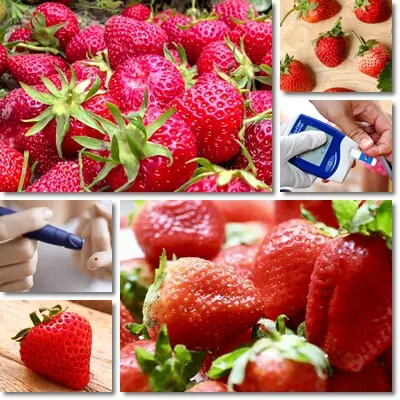If you have diabetes type 1 or type 2 or pre-diabetes and are looking for low-glycemic fruits that won’t make your blood sugar go up sky high, then know that strawberries are a great option for you. The fresh fruit have a glycemic index score of 40 and an even lower glycemic load of only 3, meaning a reasonable intake is unlikely to have too much of an effect on blood sugar. Of course, strawberries raise blood sugar because they contain carbohydrates and sugars, but the rise is manageable, modest and gradual which actually allows for better blood sugar control and, consequently, a better management of diabetes.
Strawberry glycemic index: 40 (low)
The glycemic index (GI) is a scale that estimates how fast the carbohydrates in food raise blood sugar levels. Between 0-55 is a low GI. Between 56-69 is a moderate GI. Between 70-100 is a high GI. The lower the GI score of a food, the lesser its effects on blood sugar. So if you have diabetes or pre-diabetes, then it’s good for you to eat foods with as low a GI as possible as often as possible and avoid high GI foods to the best of your efforts.

What is the glycemic index of fresh strawberries? The glycemic index of fresh strawberries is 40 (low score). Some sources purport is to be even lower, as low a 20-25 actually, but the fruit has twice the carb and sugar content of fruits with those glycemic index values which would be a bit of a stretch, but not improbable at the same time. The main take-away is that strawberries have an overall modest carbohydrate content (7.68 g of total carbs per 100 g of fruit, 2 g of which are made up of fiber) and are relatively low in actual sugar (only 4.89 g of sugar out of the total carbohydrate content).
Assuming intake is moderate, the rise in blood sugar strawberries generate is modest, manageable. Not to mention the 2 g of dietary fiber you get with every 100 g of the fresh fruit help achieve a gradual rise in blood sugar meaning the sugar is absorbed into the bloodstream at a steady rate, which is a good thing for the diabetic or pre-diabetic body. So fresh strawberries are good for diabetes because they have a low glycemic index score (40) which means they produce limited effects on blood sugar. But know they are ok only if they are consumed in reasonable amounts, according to the diabetic person’s individual nutritional requirements.
What is the glycemic index of strawberry jam/jelly? The glycemic index of strawberry jam/jelly made with sugar substitutes for diabetics is estimated to be around 51-52 (low score). However, commercial jam/jelly made with sugar, corn syrup etc. can easily rank high on the GI scale, depending on the amount of sugar or other sweeteners used to make the product. The exact GI score of a composite food product cannot be determined unless tests are done specifically on it (because it’s not just the main ingredient that counts towards the end glycemic score of the food product, but all of the ingredients used).

Strawberry glycemic load: 3 (very low)
The glycemic load (GL) is a scale similar to the glycemic index (GI), but which estimates how fast the carbohydrates in a serving of a food raise blood sugar levels. Below 10 is a low GL. Between 11-19 is a moderate GL. Over 20 is a high GL. The lower the GL, the lesser the effects on blood sugar. Even some foods with moderate or high GI values such as cantaloupe, banana or watermelon have low GL scores.
The explanation is that it all comes down to portion/serving size. The lower the portion/serving of a food, the less carbohydrates it provides. And the less carbohydrates you get, the lower the effects on blood sugar. The glycemic load (GL) of a food is determined based on the following formula: glycemic index (GI) multiplied by the number of carbohydrates in a serving of a food (expressed in grams), divided by 100. This means:
Fresh strawberry glycemic load (for a serving of 100 g) is 40 X 7.68/100 = 3.072, estimated at 3 (low GL).
The glycemic load of a cup of strawberry halves (152 g a cup) is 40 X 11.67/100 = 4.66, estimated at 5 (low GL).
The glycemic load of a cup of whole strawberries (144 g a cup) is 40 X 11.06/100 = 4.42, estimated at 4 (low GL).
Conclusion
If you are diabetic or simply looking to better manage your blood sugar, it’s best to choose fresh strawberries over strawberry juice, jam, jelly or other processed products containing the fruit. The fresh fruit will always have the best, in this case lowest, glycemic values and affect blood sugar the least, provided intake is moderate, reasonable.
If you do want to have some jam or jelly, it’s good to look for diabetes-friendly options made with sugar substitutes and, of course, keep to a fairly modest intake. A good tip is to treat the less healthy options as an occasional treat that you enjoy infrequently as well as in small amounts. Read more tips on how to eat strawberries with the metabolic condition without experiencing blood sugar spikes in the article Can You Eat Strawberries With Diabetes?
Other low glycemic fruits to consider for your nutrition: tomatoes (GI 15), sweet cherries (GI 20-25), grapefruit (GI 25), fresh and unsweetened, dried apricots (30, 30+), pears (38), apples (39), fresh figs (35-40), nectarines (40), oranges (40), plums (40), peaches (42), grapes (45-53), pomegranate seeds (53).
